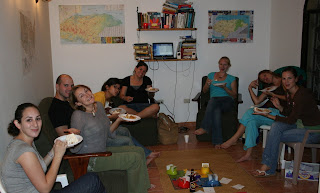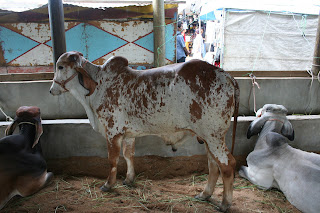This week Luke and I headed out to an aldea to work and came back with lots to write about. Luke’s assigned counterpart organization (JAM – Juntas de Agua Municipal) picked us up on Tuesday morning at 6:30 to drive us the 2 ½ hours to an aldea called El Recuerdo de la Esperanza. It was a long drive on dirt roads but luckily we were in a double-cabin Toyota pick-up so we weren’t too uncomfortable (and luckily I had remembered to take my motion sickness medicine before leaving). We went to the community with several objectives. The first was to take a look at the water tank the community has been building and check their progress of burying water pipes to get water to each house. This water project (funded by COSUDE – The Swiss Cooperation Orginization through the JAM) was supposed to be finished no later than September 30 but the community still has not completed everything (COSUDE provides all the funding for the project; the community provides all the labor, the JAM provides the technical assistance). We went to “check-up” on them and encourage them to get the project finished. The second objective of the visit was to do house-to-house visits with a community volunteer, going over basic hygiene and health issues. Part of the water project involved installing latrines for every house so I was also to go over maintenance of the latrine and make sure everyone in the family, kids included, are using it. This community is very poor and very isolated. To give you an idea of just how poor…before the water project began, only 2 of 41 houses had latrines (this means that people were just going to the bathroom somewhere outside, literally "didn´t have a pot to pis in"). Because the community is so isolated, their diet consists of mainly tortillas, beans, rice, and eggs and lacks fruits and veggies. Most of the kids are shoeless and were dirty from head to toe. A good number of them have the puffy bellies from parasites, malnutrition, or a combination of both. And, of course, there is no electricity.
We got to El Recuerdo at about 9 am on Tuesday morning after a bumpy ride and after crossing several rivers (without bridges) and many streams. We set off to hike up the mountain to visit the site of the water source and where the tank and filter are being built. The water source for the community (once the tank and system are finished) comes from several natural springs in the mountainside. The community sits in a valley with mountains on both sides. The one side of the valley is covered with vegetation and trees (the side with the water source). The other side of the community has been cleared and the farmers burn what remains in order to plant corn and beans. The side that has been slashed and burned has ZERO water sources and looks dry and dusty. (Wonder why??)
Standing on vegetated side, looking at the slashed-and-burned side.

After visiting the water tank site and filter to see how the job is coming along, we had lunch and then headed to the house where Luke and I would be staying the night. The house we stayed at was relatively nice compared to most houses in the community. There were three rooms – a kitchen and 2 bedrooms (each with 3 beds in them). Near the house that was perched on a hillside were the latrine and shower (see pic below).
The front side to this outdoor shower was open. It looked down the hill that was covered in coffee plants. No running water so we used a bucket of water and a paila (paila is a plastic container/bowl that is used here to shower, to wash dishes, hands, etc.). It was a cold, breezy shower!

Luke worked until 5 pm with some guys from the community, laying water pipe in front of the house we were staying at.
Luke working with the guys from the community

We ate dinner at 6 pm (avocado, rice, beans, and tortillas). Soon after, everyone in the house went to bed! Even though is was only 7 pm Luke and I decided to follow their lead and go to bed. It got dark around 6 pm and since there’s no electricity, by 7 pm it feels more like 10. We got out of bed the next morning around 5:15 and had the feeling that we’d missed breakfast. I asked the señora of the house (Doña Olga) what time she had gotten up at and she said 3:45! I suppose if you go to bed at 7, 3:45 doesn’t seem so early??? We had breakfast (eggs, beans, tortillas) then Luke set off for the tank to help out and I stayed around until Doña Olga (one of the community volunteers) was ready to go house to house with me. We were able to visit 13 houses in a little over 3 hours. Doña Olga did the introductions and then from there let me do the talking. At this time of day, the only people home are the wives and children. At each house I did the following things: looked over the latrine to make sure it was clean and asked to make sure everyone was using it, asked them how they were purifying their water (either by boiling it, using chlorine, or setting the water in the sun), asked about the family’s health, and if there were kids around, I gave a mini-charla on hand-washing and had all the kids wash their hands with me. I think I washed my hands with around 30 kids in all!
Clean hands! This pic was taken after I showed the kids how to wash their hands and explained to them when they should wash them.

Several things I noticed:
1) No one is purifying their water. The water system, once working, will bring treated water (with chlorine) to every house. However, currently their water is coming from a hose stuck in the mountain and they are not treating the water at all before consuming it.
2) A lot of kids were dirty and shoeless, running around outside with bare feet, stepping in chicken, pig, and/or dog poop then tracking it inside.
3) Almost every household has chickens and they are free to roam wherever and inevitably end up inside the house (see pic below of chickens roaming the front of the house where we stayed at).
4) Many women do NOT have chimneys on their wood stoves in the kitchen. In several of the houses I had to stand outside the kitchen to talk to the women because my eyes immediately started burning and I couldn´t help but cough because of all the smoke. The women are used to breathing that in on a daily basis and don’t realize it’s a health risk, especially for babies and young children. (See pic below of an example of VERY nice kitchen in a newer house in the community).
5) The kids are not in school! Apparently several months ago the teacher’s contract ran out (why the government would sign a contract that ends 4 months before the school year is over makes no sense to me!). According to many, the teacher was great and even organized a women’s group in the community. You can’t blame her for not wanting to stay if the government wasn’t going to pay her. It was sad to see all these young kids at home when I was doing the visits that should’ve been in school.
Chickens! They are very annoying and constantly try to get in the house. I took this pic right after the grandmother tossed some corn kernels on the ground for them. If this is what they call “free-range” chickens than I want mine from the cage! :)
A nice kitchen! Notice that this stove has a chimney. 
Someone came to get us on Wednesday afternoon and we made it back to Danlí by about 6:30 pm. It was a good trip and we hope to get back to the community soon to help them finish up their water project and do some health-related education. Unfortunately, Luke and I both woke in the middle of the night the night we got back with some digestive issues. I suppose this is to be expected even though we were chlorinating our water. Luckily the problems didn’t last but more than a day.
Luke and I both enjoy visiting and staying over in the campo. Living in Danlí it’s easy to forget just how isolated and poor some of the communities in Honduras are. Plus, the people are very friendly and every time we go we always end up with stories to tell!



.JPG)
.JPG)
.JPG) Sitting down to eat
Sitting down to eat.JPG)
 Luke overdid it! (see bottom of pic where he´s laying down)
Luke overdid it! (see bottom of pic where he´s laying down).JPG) Saturday am: Everyone came back for breakfast
Saturday am: Everyone came back for breakfast.JPG)
.JPG)
.JPG)






















 The week following the camp the youth leaders willwork with the kids at a school for street kids here in Danlí (the “at-risk” youth) on these topics. A youth PC volunteer works at this school on a daily basis. The leaders were divided up into four groups, each assigned with a different topic to work with the kids on. I was assigned to help lead the HIV/AIDS project. My group came to Danlí the Wednesday after the camp and we worked with the kids from this school for several hours on HIV/AIDS prevention. I helped the young leaders design the presentation and activities but just sat back while they led it. We gave the presentation to the 10-15 year-olds at the street school. They had never received a formal HIV/AIDS charla before so it was interesting to see what beliefs they had about HIV/AIDS (one thought, for example, that there was a cure). I felt, and so did the leaders, that the kids learned a lot. And the leaders had a great time doing it! Some of them mentioned wanting to come back and volunteer at the school.
The week following the camp the youth leaders willwork with the kids at a school for street kids here in Danlí (the “at-risk” youth) on these topics. A youth PC volunteer works at this school on a daily basis. The leaders were divided up into four groups, each assigned with a different topic to work with the kids on. I was assigned to help lead the HIV/AIDS project. My group came to Danlí the Wednesday after the camp and we worked with the kids from this school for several hours on HIV/AIDS prevention. I helped the young leaders design the presentation and activities but just sat back while they led it. We gave the presentation to the 10-15 year-olds at the street school. They had never received a formal HIV/AIDS charla before so it was interesting to see what beliefs they had about HIV/AIDS (one thought, for example, that there was a cure). I felt, and so did the leaders, that the kids learned a lot. And the leaders had a great time doing it! Some of them mentioned wanting to come back and volunteer at the school.








.JPG)
.JPG)
.JPG)

.JPG)
.JPG)
.JPG)

